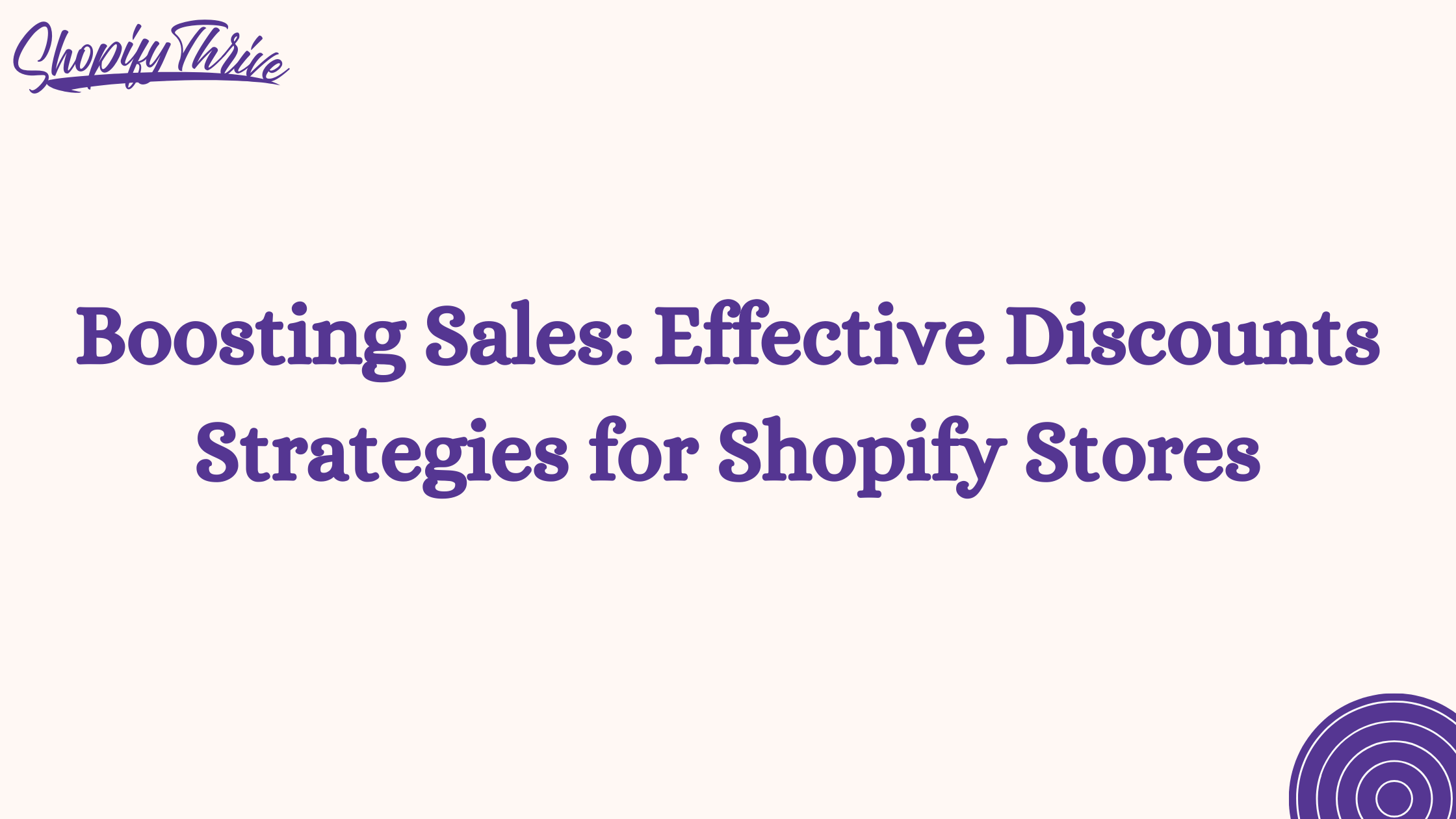
Noor
Boosting Sales: Effective Discounts Strategies for Shopify Stores
- July 11, 2023
- , 5:27 pm
- , Shopify Tips
1. Introduction
Discounts can be a powerful driver of sales for Shopify stores. When used strategically, they can attract new customers, retain existing ones, and stimulate additional purchases. However, it’s crucial to approach discounting with a well-thought-out plan to ensure maximum effectiveness and profitability.
2. Creating Effective Discounts
To create compelling discounts that drive sales, it’s important to follow a structured approach. The MECE (Mutually Exclusive, Collectively Exhaustive) framework can help you cover all the essential elements. Let’s dive into each step:
Defining Goals and Objectives
- Clearly identify the purpose of your discounts, whether it’s to increase overall sales, drive traffic, promote specific products, or incentivize customer loyalty.
- Establish measurable goals to track the success of your discount campaigns.
Determining Discount Types
- Explore different discount types, such as percentage-based discounts, fixed amount discounts, buy-one-get-one (BOGO) offers, free shipping, or bundled discounts.
- Consider the context of your products and target audience to choose the most enticing discount type.
Setting Discount Parameters
- Define the duration of your discounts, whether they are short-term flash sales, seasonal offers, or long-term promotions.
- Establish any limitations or restrictions, such as minimum order values, maximum usage per customer, or specific product exclusions.
Utilizing Urgency and Scarcity
- Create a sense of urgency by using limited-time offers, countdown timers, or limited stock availability.
- Communicate scarcity by indicating limited quantities or exclusive access to certain products.
3. Targeting Your Discounts
Tailoring your discount offers to specific segments of your customer base can significantly improve their effectiveness. Consider the following approaches:
Segmenting Your Customer Base
- Divide your customers into distinct segments based on demographics, purchase history, interests, or engagement levels.
- Use customer relationship management (CRM) tools to categorize and target each segment separately.
Personalizing Discount Offers
- Leverage customer data to personalize discounts based on individual preferences, past purchases, or browsing behavior.
- Send targeted email campaigns with unique discount codes to create a personalized experience.
Retargeting Abandoned Carts
- Implement strategies to re-engage customers who have abandoned their shopping carts.
- Offer personalized discounts to entice them back to complete their purchase.
Leveraging Customer Behavior
- Analyze customer behavior, such as browsing patterns, wish lists, or product views, to determine appropriate discount offers.
- Use automated systems to trigger personalized discounts based on specific customer actions.
4. Tracking and Analyzing Discount Performance
Tracking and analyzing the performance of your discount campaigns is crucial for optimizing their effectiveness. Consider the following steps:
Setting Up Conversion Tracking
- Implement conversion tracking tools, such as Google Analytics or Shopify’s built-in analytics, to monitor the impact of discounts on sales and revenue.
- Set up unique discount codes or landing pages to track specific campaigns accurately.
Monitoring Key Metrics
- Track key performance indicators (KPIs) such as conversion rates, average order value, customer acquisition cost, or customer lifetime value.
- Compare the performance of discount campaigns against your established goals and benchmarks.
Analyzing Customer Behavior
- Analyze customer data to understand how discounts influence purchasing behavior, customer retention, or customer satisfaction.
- Identify patterns and trends to refine your discount strategies and optimize future campaigns.
A/B Testing and Iteration
- Conduct A/B tests to compare different discount offers, messaging, or targeting strategies.
- Continuously iterate and refine your discount campaigns based on data-driven insights.
5. Best Practices for Discount Strategies
To ensure the long-term success of your discount strategies, keep the following best practices in mind:
Maintaining Profit Margins
- Set discount thresholds that preserve your profit margins and avoid excessive revenue loss.
- Consider upselling or cross-selling complementary products to increase overall revenue.
Offering Exclusive Discounts
- Create a sense of exclusivity by offering discounts to loyal customers, email subscribers, or members of your loyalty program.
- Use tiered discount structures to reward high-value customers.
Building Customer Loyalty
- Use discounts as a tool to foster customer loyalty and repeat purchases.
- Consider implementing a points-based loyalty program that rewards customers with exclusive discounts or benefits.
Encouraging Social Sharing
- Offer discounts or incentives for customers who share their purchases or referral links on social media.
- Leverage user-generated content and positive reviews to build trust and attract new customers.
6. Conclusion
Discounts can be a valuable strategy to increase sales for your Shopify store when implemented thoughtfully and strategically. By creating effective discounts, targeting specific customer segments, and diligently tracking and analyzing performance, you can optimize your discount campaigns to drive revenue growth and outperform your competitors in the online marketplace. Remember to adapt your strategies based on customer behavior, maintain profitability, and prioritize customer loyalty for long-term success.
If you enjoyed this blog post, make sure to check out some of our other useful Shopify tips here: Shopify Tips Archives | Shopify Thrive
Ready to transform and grow your shopify brand?
See why companies like Lash Artisan, Lust For Lashes, joemetry.co and more
launched their shopify Brand With ShopifyThrive.
